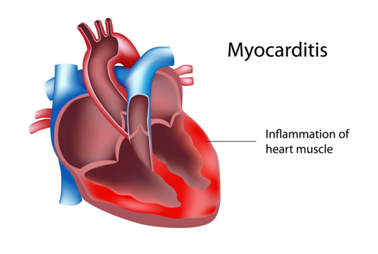Myocarditis is an inflammation of the heart tissue, specifically the myocardium, the middle layer of the heart wall. Myocarditis affects your heart’s electrical system and muscle cells, leading to irregular heart rhythms and problems with the heart’s pumping function.
Viral infections are the leading cause of myocarditis. Common viral infections that can lead to myocarditis include: COVID-19, hepatitis B and C, parvovirus, and even the common cold. Cancers, bacterial infections, and parasites can also cause myocarditis.


Myocardial Edema
- The fatal feature of myocardial edema or inflammation formation is that it not only impedes the pumping function of the heart in a purely mechanical manner but also exerts a proinflammatory effect, induces fibrosis, stimulates exuberant collagen synthesis in the interstitium by upregulating transforming growth factor-beta and the pro-collagen type I and type III, resulting in increased collagen deposition.40,41 In addition, there is evidence indicating that the excitation-contraction uncoupling induced by myocardial edema causes contractile dysfunction.17,42 Experimental removal of edema leads to an immediate improvement in the contractility of the heart.30
Microcurrent Treatment Mechanisms
- Although electro-osmosis is well known in biophysics and biology, it is hardly known in medicine. It describes the phenomenon of the movement of a liquid through a capillary vessel bearing a surface charge caused by an electrical field parallel to the surfaces of the vessel.34,46,47 Electro-osmotic flow may occur through small-channel structures such as gap junctions, capillaries, cells, and cell membranes across a heterogenous group of tissues. In particular, electro-osmotic flow can be found in areas of high electrical activity.48–50 In addition to the flow generated by pulsatile or osmotic and hydrostatic pressure differences, electrokinetic flow is a relevant transport mechanism in even the smallest lymphatic and blood vessels.51 Thus, edema formation can be interpreted in part as a disturbed electrical environment generating a potential gradient in the myocardium. This environment includes the negatively charged intraluminal layer (glycocalyx) of the fluid exchange vessels; this layer controls the permeability of the capillary wall and, in turn, the fluid balance and pressure conditions in the interstitium.
- An externally applied weak electric current together with an electrical field can interrupt the vicious circle of edema formation and impaired cardiac performance. It normalizes the electrical environment with the consequence of increasing lymphatic flow by supporting the electrokinetically induced transport of electro-osmosis and electrophoresis and may also influence the charge of the glycocalyx.50
CellStim Microcurrent Therapy (CMT) involves the use of very low-level electrical currents to stimulate tissues and promote healing. For treating myocarditis inflammation, electrode pads can be placed on the chest area, specifically in the vicinity of the heart at the 2nd and 4th Intercostal space along left Sternal Border.
CellStim CS400T parameters:
Frequency set to 0.3 Hz
Current intensity set to 300 uA or sub-threshold
Biphasic waveform (Triphasic Switch center position)
Treatment duration: 30 minutes per day


- Myocarditis is a serious condition and any intervention should be done under medical supervision to ensure safety and effectiveness. Always consult with a healthcare provider for appropriate diagnosis and treatment options.
References
Cardio‐microcurrent device for chronic heart failure: first‐in‐human clinical study (Apr 2021)
https://www.ncbi.nlm.nih.gov/pmc/articles/PMC8006737/
The underlying mechanism may be restoration of endogenous electric potential gradients improving myocardial function. The rapidity with which these improvements occur suggests that microcurrent, mediated by electro‐osmosis, could have a direct effect the myocardial oedema that often accompanies heart failure.
{1} Myocardial Edema Revisited in a New Paradigm of Cardiac Electrical Microcurrent Application in Heart Failure (Sep 2021)
https://www.liebertpub.com/doi/full/10.1089/bioe.2021.0021
The early improvement in cardiac function after the application of a microcurrent directly to and around the heart could implicate favorable changes in myocardial edema, which heretofore has not been a clinical target in human heart failure.
Microcurrent stimulation promotes reverse remodelling in cardiomyocytes (Jan 2016)
https://www.ncbi.nlm.nih.gov/pmc/articles/PMC5064659/
In this study, using a novel methodology, we show that application of MC can modulate the expression of MMPs and TIMPs in cardiomyocytes in vitro and in heart tissue in vivo.
https://heart.magnusconferences.com/program/scientific-program/2023/a-novel-approach-to-the-treatment-of-heart-failure-by-the-application-of-a-pulse-free-constant-direct-electrical-microcurrent
COVID-19 vaccine induced myocarditis in young males: A systematic review
https://onlinelibrary.wiley.com/doi/10.1111/eci.13947
39 cases per 100,000 persons
